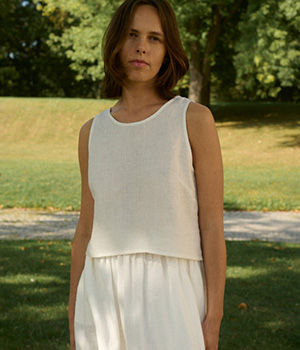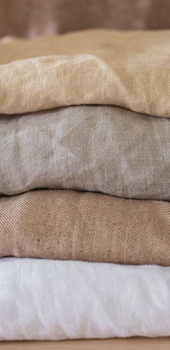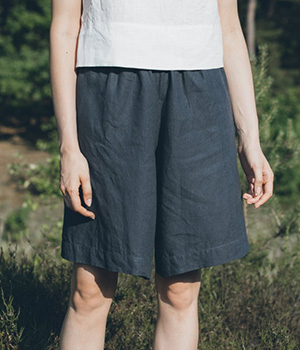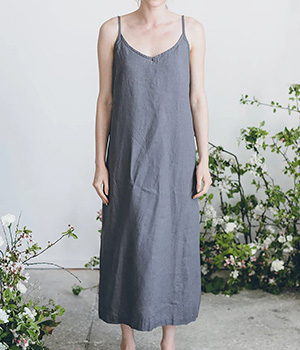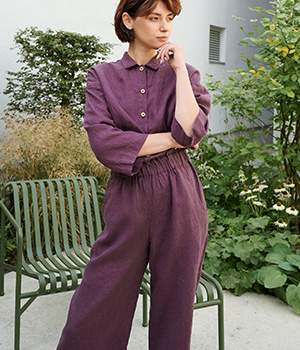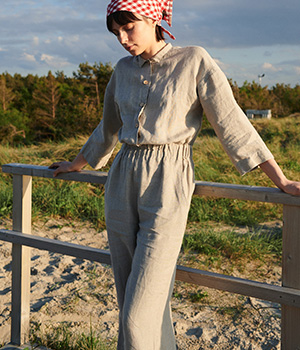High-Quality Linen Dress Manufacturing Standards: What Makes Top Factories Stand Out

Introduction
In today’s global fashion industry, the premium segment of linen apparel is increasingly defined not just by design or fibre, but by the standards of its manufacture. For brands seeking to deliver exceptional linen collections, understanding what constitutes world-class linen dress manufacturing is essential. From fabric sourcing and build integrity to finishing, packaging, and compliance — every stage matters. This blog, High-Quality Linen Dress Manufacturing Standards: What Makes Top Factories Stand Out, serves as your comprehensive guide. We will examine the key manufacturing benchmarks every brand should expect when commissioning linen dresses, and highlight how choosing the right partner can elevate your brand. In this context, I’d like to introduce our company, Linenwind — where we bring together two decades of garment industry experience, a low MOQ of 60 pieces for sample and capsule runs, and a full in-house OEM & ODM approach to developing a linen portfolio. Whether you are launching your first linen line or expanding into capsule collections, mastering standards in linen dress manufacturing ensures you meet today’s demand for quality, ethics, and reliability.
Why Linen Dress Manufacturing Demands Higher Standards
When it comes to linen apparel, especially dresses, the unique properties of the fibre mean that the manufacturing process must be handled with specialised care. Here’s why excellent linen dress manufacturing standards matter:
Fabric behaviour and finish sensitivity: Linen, derived from flax, has a distinct texture, natural variation, and limited elasticity. According to textile-fabric sources, linen’s production requires more careful processing than many cotton alternatives. A factory that treats linen as simply “another fabric” risks inconsistency in drape, shrinkage and hand-feel.
Premium consumer expectations: In the high-end market, linen dresses are positioned as sustainable luxury. Brands expect a consistent finish, minimal defects, accurate sizing and premium packaging — all of which require manufacturing standards beyond generic garment lines.
Sustainability and traceability: Linen is often chosen for its eco credentials. To preserve that story, manufacturing must adhere to standards (e.g., chemical safety, labour conditions, certifications) so that the claim of “linen dresses produced responsibly” is authentic.
International compliance and export readiness: For brands selling in Europe, North America or other regulated markets, manufacturing standards in sizing, labelling, chemical limits and worker welfare are non-negotiable. Factories must meet or exceed these standards to avoid recalls or compliance issues.
International compliance and export readiness: For brands selling in Europe, North America or other regulated markets, manufacturing standards in sizing, labelling, chemical limits and worker welfare are non-negotiable. Factories must meet or exceed these standards to avoid recalls or compliance issues.
Supply chain reliability and brand risk: A mis-run production batch for a linen dress collection can damage brand reputation. Delays, defects or mis-sizing impact inventory, retail launches and consumer trust — hence why many brands now specify stringent manufacturing standards rather than simply sourcing based on cost.
Because of these factors, entering into linen dress manufacturing without a clear understanding of standards and partner capabilities is risky. In the next section, we’ll break down the most important manufacturing standards for linen dresses and what you should expect from your factory-partner.

Key Manufacturing Standards for Linen Dress Production
To ensure high-quality output in linen dress manufacturing, brands should expect their manufacturing partner to meet or exceed the following standards across the production lifecycle:
Fabric Sourcing & Quality Verification
A top-tier linen dress factory sources premium flax-based fabrics and verifies their performance. Fabrics should be tested for weight (gsm), weave stability, shrinkage allowance, and hand-feel. Textile guides note that linen production includes careful monitoring of fibre sources and finishing.
Pre-Production Sampling & Prototyping
Pre-Production Sampling & Prototyping
Before bulk manufacture, your partner should produce a pre-production sample (PPS) for approval — including measurements, fabric hand, trimming, finishing, and packaging. Any discrepancies in the sample should be corrected before mass runs.
Certification & Compliance
The factory should hold recognised certifications for textile safety, worker welfare, and environmental management. For example, fabrics may carry OEKO‑TEX Standard 100 certification (which governs harmful substances in textiles) or the factory may hold ISO 9001 / BSCI auditing for production and labour standards.
Quality Control & Statistical Inspections
Quality Control & Statistical Inspections
During the bulk production of linen dresses, rigorous quality control is essential. This includes inline inspections (fabric checking, stitch monitoring, seam strength testing), final AQL (Acceptable Quality Limit) inspections and full documentation of defects and corrective actions. Without such processes, brands risk irregular sizing, bad finishing or colour mismatch.
Tailoring & Construction Standards
Because linen doesn’t have the stretch of some synthetics, construction must be accurate: correct cutting, reinforced seams, appropriate finishing treatments (e.g., enzyme wash, preshrink) and consistent labelling. The pattern must account for linen’s unique behaviour (e.g., shrinkage, relaxation after wash).
Finishing & Packaging Excellence
The finishing stage defines the consumer experience. A factory should ensure your linen dress has the correct drape, minimal unwanted shrinkage, consistent colour tracking, and that packaging reflects your brand standards. Sustainable and premium packaging enhances the perceived value of the product.
Traceability & Documentation
Brands are increasingly required to document their supply chain for ethical, environmental and regulatory reasons. A factory must provide batch records, material traceability (e.g., flax origin, dye lot numbers), worker records, and export documentation.
Delivery Reliability & Risk Management
High-quality linen dress manufacturing isn’t just about making clothes; it’s about delivering on time, at the right quality and volume. The factory must demonstrate capacity management, contingency planning, and transparent timeline tracking.
By ensuring your manufacturing partner meets these standards, you safeguard your collection, protect your brand and ensure your linen dresses meet both fashion and quality objectives. In the next section, we will introduce how Linenwind meets and surpasses these benchmarks as a trusted partner in linen dress manufacturing.
Linenwind — Setting the Standard in Linen Dress Manufacturing
At Linenwind, we believe that exceptional linen dress manufacturing is a combination of craftsmanship, technology, and responsibility. With more than 20 years of garment manufacturing experience, we’ve developed a vertically integrated system that ensures precision and consistency from concept to final shipment.
🌿 About Linenwind
🌿 About Linenwind
We are an eco-conscious manufacturer dedicated to producing linen garments that blend aesthetic appeal with sustainability. As one of the few factories specialising exclusively in linen apparel, we understand how to respect the fibre’s natural characteristics while achieving the finishing standards that international brands expect.
🌿 Our Key Advantages
Eco-friendly production: We prioritise sustainable linen sources, low-impact dyeing, and OEKO-TEX-certified fabrics.
Full in-house OEM & ODM services: From pattern design and sampling to packaging, every process is under one roof for total quality control.
Low MOQ (60 pieces): Perfect for small-batch brands or market-testing capsules.
Real-time quality monitoring: Digital reporting keeps clients informed throughout production.
Dedicated project management: Each client works with a personal account manager who ensures seamless communication.
⚙ Our Mission
We don’t simply produce dresses — we co-create fashion statements that reflect our clients’ values. By integrating design, manufacturing, and sustainability, Linenwind provides a complete solution that exceeds global standards for linen dress manufacturing.

How Linenwind Implements Global Manufacturing Standards
As sustainability and quality expectations grow, Linenwind consistently benchmarks its production system against international manufacturing standards. Here’s how we translate global principles into everyday factory operations:
Fabric Sourcing & Quality Control
We collaborate with verified linen mills supplying OEKO-TEX-certified fabrics, ensuring traceable, chemical-safe flax. Every incoming batch undergoes weight, shrinkage, and colourfastness testing before production begins.
Advanced Cutting & Pattern Engineering
Our CAD system optimises pattern layout to reduce waste while ensuring precision. Linen’s minimal elasticity requires accuracy within ±1 mm tolerance for panel cutting.
Skilled Sewing & Tailoring
Each operator in our sewing department is trained in handling linen specifically — maintaining seam strength, controlling puckering, and applying reinforced stitches in stress areas.
Finishing & Pre-Wash Treatment
We use pre-wash, enzyme wash, and softening processes to ensure the final linen dress has the correct drape and touch. Finishing is inspected under consistent lighting for colour uniformity.
Inline & Final Inspection Protocols
Every stage is monitored using AQL 2.5/4.0 standards. Inline inspectors check random samples hourly, while final audits include measurement verification, seam durability, and packaging review.
Sustainable Facility Management
Our plant meets ISO 9001 and BSCI requirements for quality and labour practices. Waste water is filtered and recycled, and energy use is monitored digitally to lower emissions.
Digital Production Tracking
Clients can monitor their linen dress manufacturing process in real time through digital progress reports and visual updates. This transparency eliminates uncertainty and builds long-term trust.
Training & Continuous Improvement
Our QA and production teams undergo continuous training to update skills in linen fabric handling, sustainability reporting, and lean production.
This consistent implementation of standards allows Linenwind to maintain international competitiveness while offering boutique-level flexibility and attention to detail.
The Linenwind Manufacturing Process — From Concept to Finished Dress
The journey of a custom linen dress at Linenwind follows a systematic, transparent, and ethical process designed for both startups and established brands:
Step 1 – Consultation & Design Brief
We begin with your creative vision. Whether you provide sketches or mood boards, our designers help refine silhouettes and suggest suitable linen weights and finishes.
Step 2 – Fabric Selection & Testing
We source the best linen fabrics based on your design requirements: lightweight for summer, medium-weight for structured shapes, or blends for wrinkle resistance. Each fabric is tested for colourfastness, shrinkage, and tensile strength.
Step 3 – Pattern Development & Sampling
Using CAD technology, we create digital patterns to ensure accuracy. A prototype sample is produced within 7–10 days for client approval.
Step 4 – Production Planning
Once approved, our production team sets timelines, fabric consumption, and order allocation. Clients receive a Gantt-style schedule showing each milestone.
Step 5 – Cutting & Sewing
Automated cutting machines ensure precision. Our sewing lines maintain clean seams, even stitch density, and accurate fit across all sizes.
Step 6 – Finishing, Washing & Ironing
Garments undergo softening, tumble drying, and pressing before final inspection. This gives each linen dress a luxurious feel while maintaining durability.
Step 7 – Quality Inspection & Packaging
Every piece passes through multi-stage inspections, from seam to label accuracy. We use eco packaging materials that align with your brand’s sustainability values.
Step 8 – Delivery & After-Sales Support
Products are shipped globally via sea or air, with full logistics tracking. Our after-sales team assists with reorders, feedback and seasonal planning.
This process ensures that every linen dress manufacturing project at Linenwind results in garments that meet both aesthetic and technical excellence — combining comfort, durability, and elegance.
Global Market Trends in Linen Dress Manufacturing (2025 – 2028)
Sustainability Is No Longer Optional
Smart Automation Meets Artisanal Craft
According to Fibre2Fashion forecasts, the global linen apparel market will surpass USD 17 billion by 2028, driven by demand for sustainable fibres. Factories that integrate eco-certified processes — such as water recycling, renewable energy, and OEKO-TEX fabrics — now set the benchmark for linen dress manufacturing excellence.
Smart Automation Meets Artisanal Craft
The most successful manufacturers combine modern machinery with skilled craftsmanship. Automated cutting ensures accuracy, while traditional finishing preserves the soft, hand-made quality of linen garments. Linenwind embodies this hybrid model — precision and artistry coexisting in one workflow.
Shorter Lead Times and Flexible MOQ
Today’s fashion cycles demand agility. Brands need fast sampling and short production runs. High-end linen dress manufacturing facilities like Linenwind support MOQs as low as 60 pieces while scaling up rapidly when collections expand.
Data-Driven Quality Assurance
Factories now employ digital dashboards to monitor production progress and defect rates. This transparency builds trust and enables brands to forecast inventory with accuracy.
Regional Diversification of Production
While China remains the primary hub for linen apparel, Southeast Asia and parts of Europe are expanding their capacity. Yet the most competitive factories will be those offering both global compliance and boutique-level service — exactly what Linenwind delivers to clients worldwide.
Buyer Checklist — How to Identify a Reliable Linen Dress Manufacturer
When evaluating potential partners for your linen dress manufacturing needs, use this ten-point checklist:
1️⃣ Material Expertise — Do they specialise in linen or treat it like cotton?
2️⃣ Certifications — Are fabrics OEKO-TEX certified and facilities ISO 9001 / BSCI audited?
3️⃣ Sampling Efficiency — Can they deliver a prototype within 7–10 days?
4️⃣ MOQ Flexibility — Can they start from 60 pieces and scale to thousands?
5️⃣ Sustainability Practices — Ask for energy-saving data, wastewater treatment details, and chemical-safety compliance.
6️⃣ Technical Precision — Check their cutting tolerances, seam reinforcement, and finishing quality.
7️⃣ Transparency — Do they provide photo or video updates throughout production?
8️⃣ Packaging & Branding — Can they support private-label packaging consistent with your brand?
9️⃣ Delivery & Logistics — Ensure they have proven on-time shipping performance.
🔟 After-Sales Support — A reliable partner maintains open communication for feedback and reorders.
✅ At Linenwind, every box above is ticked. We guide clients step-by-step — from initial design to export — providing full visibility and peace of mind.

Case Studies — Real Proof of Quality in Linen Dress Manufacturing
Case 1 – European Luxury Label
A Copenhagen-based label commissioned Linenwind to produce 300 linen wrap dresses with tailored sleeves. We implemented reactive dyeing and enzyme-softening processes to meet luxury tactile standards. The dresses achieved a 98 % sell-through within eight weeks, confirming the commercial impact of precision manufacturing.
Case 2 – Australian Sustainable Startup
A small resort brand needed 80 pieces for a pilot collection. Thanks to our low MOQ and rapid sampling, they launched on schedule with zero inventory risk. Post-launch feedback highlighted “superior softness and flawless stitching.”
Case 3 – North American Retail Group
For a U.S. lifestyle retailer, we produced 1,500 linen shirt-dresses under private label. Using automated cutting and inline QA, the order achieved less than 1 % defect rate. Our team handled design, sewing, packaging, and shipment tracking — a complete OEM solution.
These examples demonstrate that high-quality linen dress manufacturing is not theory — it’s measurable performance: consistency, compliance and craftsmanship. Linenwind’s results prove that even boutique-scale production can reach world-class standards.
Conclusion — Why Linenwind Sets the Global Benchmark
As the demand for sustainable luxury grows, the bar for linen dress manufacturing continues to rise. Brands today need partners who combine ethical practices with engineering precision and design flexibility.
At Linenwind, we embody those standards. With 20 years of experience, a low MOQ of 60 pieces, and full in-house OEM & ODM capabilities, we ensure every linen dress reflects your brand’s aesthetic and sustainability ethos. From eco-friendly fabrics to real-time QA and private-label packaging, our vertically integrated system eliminates the usual barriers between design and production.
Discover our Custom Linen Dress Collection, explore our OEM & ODM Service, or Contact Us to start your next collaboration.
Let’s craft the future of linen fashion — sustainably, beautifully, and with the precision only true experts can offer.

